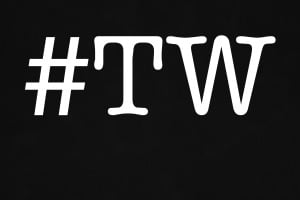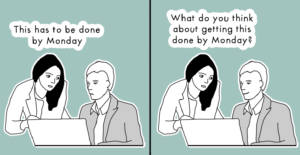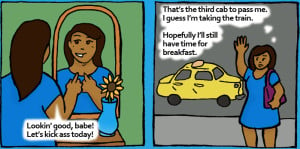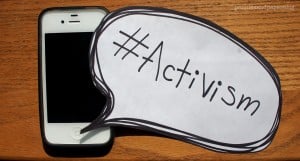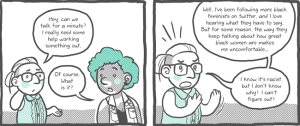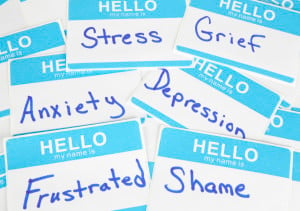“But aren’t trigger warnings patronizing? I find it pretty patronizing to say that all rape survivors should avoid reading this article,” said a person I encountered in a feminist group on Facebook.
I sighed heavily.
I encounter this kind of response to trigger warnings every day: People – who, by their own admission, have not experienced sexual abuse or mental illness — are offended on my behalf by trigger warnings.
As a mentally ill person, I’m constantly told that the precautions I may take to avoid a nervous breakdown are patronizing – usually by non-mentally-ill people who don’t find it ironic that they’re telling me to feel patronized.
This response to trigger warnings is not uncommon. There has been a great deal of debate on where, when, and simply if we should use trigger warnings.
Thousands and thousands of words have been written about whether we should add a handful of words at the beginning of our blog posts, articles, and Facebook statuses.
I understand why people are wary of trigger warnings; for a long time, I was cautious, too. I initially thought that they were pretty patronizing and counter-productive – but admittedly, that was because I wasn’t too clued up about what trigger warnings are and how they’re meant to function.
Trigger warnings can be pretty confusing. So here’s a primer on why, when, and where they can (and in some cases, should) be used.
What Are Trigger Warnings?
Trigger warnings are notes that preface possibly traumatic content.
They warn the audience of any content that has a strong possibility to trigger (or cause) a severe negative emotional response.
Trigger warnings are most often used online, particularly in social justice spaces and on social media.
Trigger warnings are usually aimed at helping people with mental or psychological disabilities, illnesses, and challenges – such as post-traumatic stress disorder, anxiety, and depression. That being said, people who don’t have psychological or mental difficulties might also use trigger warnings.
Some people use “content notes” or “content warnings” instead of “trigger warnings.” Some prefer to avoid the use of the word “trigger,” which may be triggering in and of itself, evoking images of guns and shootings.
There is no definite consensus on the difference between content notes and warnings. This being said, I’ve seen many people use “content notes” to refer to things that might not be triggering, while using warnings to refer to potentially triggering material.
For example, I’ve seen people use “content notes” to warn readers of long rants, articles containing videos, bandwidth-intensive websites, and inaccessible content: basically, anything the audience might want to avoid.
But whether it’s a trigger warning, a content warning, or a content note, the general purpose is to give the reader a heads up about what’s coming so that they can decide whether or not they’re in a place to proceed.
When Do We Use Trigger Warnings?
Trigger warnings commonly warn the audience of the following:
- Descriptions and discussions of abuse
- Descriptions and discussions of mental illness
- Descriptions and discussions of hate crimes
- Descriptions and discussions of self-harm, including suicide
- Mentions of hate groups
This being said, there is no definite consensus on what needs a trigger warning. The way trigger warnings are used depends on who decides to use them and where they are used.
This is where it gets tricky. Everything has the potential to remind someone of a traumatic event. Anything can be triggering because anything could remind someone of a traumatic event.
But at the same time, we can’t give warnings for absolutely everything. For example, I am triggered by a song which reminds me of the day I was raped, but I can’t expect trigger warnings to warn me if an article mentions that song.
For this reason, trigger warnings generally warn for common triggers (like if a piece graphically describes sexual violence or contains sexually violating language). Of course, this brings up an important question: Who has the authority to decide what is triggering and what is not?
I would argue that it depends on the kind of space in which they are used.
On your personal Facebook page, for example, you should have the authority over which trigger warnings to use. However, your personal Facebook posts still have the potential to trigger your friends and followers, so if you want to avoid triggering them, you could perhaps have a status asking which trigger warnings your friends need. If you have friends who use trigger warnings, you can also take note of which warnings they use and use those warnings on your posts, too.
This might become more difficult in community spaces, such as Facebook groups and pages and online forums. If those spaces are trying to be shared safe spaces, it might be difficult to decide what warrants a trigger warning and what doesn’t. In order to address this problem, some groups simply ask: They open a thread asking members which trigger warnings they need.
In other cases, sometimes you might post triggering material by accident, only to have a friend let you know that they found the post upsetting and wished that it had had a trigger warning. In this case, you can apologize and then add a trigger warning to the post.
In general, if you know that what you’re posting might be upsetting for some (think: any topic where the word “sufferer,” “victim,” or “survivor” could be applied), a trigger warning could be used.
How Do People Use Trigger Warnings?
I’m not going to pretend that I can be objective about trigger warnings; I rely on them often.
I live with post-traumatic stress disorder and anxiety. I am fortunate to have a network of extremely supportive people, so I’m able to handle these mental illnesses quite well most of the time.
But sometimes, life is incredibly hard to handle for me. Sometimes I need to be gentler with myself. Sometimes I need to avoid material that may remind me of my past traumas. If I don’t avoid this stuff, my mental state would become aggravated, and I would become even less able to function.
For me, not being able to function means being unable to eat, only wanting to sleep, becoming isolated from my loved ones, and losing out on much-needed income.
Trigger warnings make it a lot easier for me to avoid triggering material because they give me a heads up about triggering material.
The way that I use trigger warnings depends on my mental state.
For example, if I see a trigger warning on an article that I’d like to read and I’m in a good emotional and mental state, I might ignore it and go ahead and read the piece. I also might read the trigger warning and decide to take a few breaths to mentally prepare for the content, or if I’m in a very difficult place, I’d make a note to read the article when I feel better.
Trigger warnings make it possible for me to survive.
Obviously, the way I use trigger warnings isn’t the way everyone uses trigger warnings. People experience mental illnesses differently, and people heal differently. But trigger warnings are tools which we can use to heal in our own ways.
It is important to note that trigger warnings shouldn’t tell a group of people how to handle the material. That is, trigger warnings aren’t suggesting the audience avoid the piece entirely. Rather, they tell the audience what’s coming up. In this sense, trigger warnings should empower the audience and not instruct them.
Why Are They Important?
Trigger warnings are important because they make it possible for people – particularly mentally ill people – to participate in certain spaces.
I’ve written about the importance of online safe spaces before: Safe spaces are important because they make it possible for marginalized people to participate in online discussions. When marginalized people feel safe in a certain space, they’re more likely to want to participate meaningfully and authentically in discussions and activism.
Those of us who need trigger warnings often feel more comfortable participating in a space where people don’t often post triggering material without warnings. This means that we’re more likely to participate in discussions.
So—Wait—Why Are They So Controversial?
We live in an ableist world – a world that caters for those who don’t have disabilities and oppresses those who do.
Trigger warnings are a way for people to cater to those who are mentally ill or people who might be deeply hurt by certain material. In a society that is dismissive of mental illness and trauma, using trigger warnings is a revolutionary act.
Consider how mentally ill people are often told to “just get over it.” We’re often told that our illnesses don’t exist at all. The use of trigger warnings acknowledges that mental illnesses are not only real, but that society should make an effort to be more attentive to the needs of the mentally ill.
It removes the responsibility from the mentally ill to “just get over” our illnesses and places some responsibility in the hands of others.
The effective use of trigger warnings requires sensitivity.
In order to avoid triggering others, we need to be attentive to their needs, as well as mindful of our own privilege.
For example, I am cisgender, and I’m privileged in that regard. Transphobia, while it’s upsetting, doesn’t trigger me, because as a cisgender person, I’m not victimized by transphobia. So when I share posts that contain or discuss transphobia, I use trigger warnings and I am reminded that I have cisgender privilege.
And this is another reason why many people dislike trigger warnings: It reminds us of our privileges, and that makes us uncomfortable. Using trigger warnings is to acknowledge that others hurt in a way that we might not.
***
Trigger warnings are often poorly understood. But they’re incredibly important and useful for those who need it. It helps us create safe spaces, and it enables us to cater to those who are mentally ill.
If we recognize that people are oppressed, we must also recognize that the effects of that oppression will leave its marks on that person.
In order to empower those oppressed people, we have a moral and ethical duty to provide them with as many tools to navigate their own healing. Trigger warnings are just one of the many things we can do to achieve that.
[do_widget id=”text-101″]
Sian Ferguson is a Contributing Writer at Everyday Feminism. She is a South African feminist currently studying towards a Bachelors of Social Science degree majoring in English Language and Literature and Gender Studies at the University of Cape Town. She has been featured as a guest writer on websites such as Women24 and Foxy Box, while also writing for her personal blog. In her spare time, she tweets excessively @sianfergs, reads about current affairs, and spends time with her gorgeous group of friends. Read her articles here.
Search our 3000+ articles!
Read our articles about:
Our online racial justice training
Used by hundreds of universities, non-profits, and businesses.
Click to learn more


